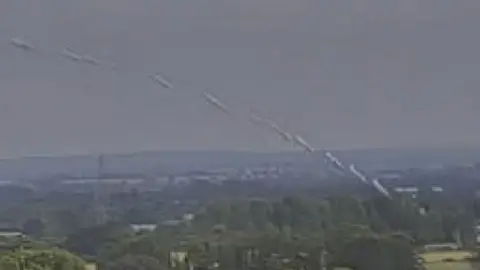No obvious defects on fatal crash plane - report
 Handout
HandoutA plane which crashed two years ago, killing its pilot, had "no identifiable defects", a report has found.
Harvey Dunmore, 21, died when the Piper light aircraft nose-dived on approach to Bagby Airfield near Thirsk where it was due to land, according to the Air Accidents Investigation Branch (AAIB).
In 2023, three men, aged 37, 55 and 68, were arrested on suspicion of manslaughter and questioned by North Yorkshire Police, before being released under investigation.
Following the report's publication, the force confirmed its investigation was still ongoing, with no further developments.
 AAIB
AAIBMr Dunmore had flown the twin-engine light aircraft from Bagby Airfield to Deauville in France on 6 July 2023, according to the report.
He collected five passengers and delivered them to Abbeyshrule in Ireland, before returning to Bagby.
A "normal" radio call was made to the airfield to say that he was four miles away, the AAIB added, but CCTV then showed the Piper PA-23-250 (G-BKJW)'s angle of descent steepen.
"The ground impact caused a fire, and the accident was not survivable," it said.
 AAIB
AAIBThe AAIB said a post-impact fire "destroyed a significant amount of physical evidence".
One "anomaly", however, suggested a "pitch trim runaway" was the most likely cause of the nose-dive, the report said.
An AAIB spokesperson said this was a situation where a system aimed at reducing a pilot's workload, by controlling the pitch, malfunctioned.
It could "cause the the aircraft to pitch nose-down or nose-up without any input from the pilot", they said.
"The failure can require considerable input force by the pilot to regain control, and if the trim system is not deactivated promptly it can lead to a loss of control."
According to the report, there was insufficient evidence to determine pitch trim runaway as the "definitive cause of the accident", but other possible reasons were found to be unlikely.
CAA safety actions
The AAIB said that irrespective of whether such an event caused the crash at Bagby Airfield, the investigation "identified ways to reduce the risk".
Eight safety actions were planned by the Civil Aviation Authority (CAA), concerning four areas including training for a pitch trim runaway.
Deactivating inoperative autopilots, making autopilot and electric trim circuit breakers more visible and providing clearer information regarding differences training requirements were also highlighted.
The report stated that the plane was owned by an Irish business with four directors based at Abbeyshrule airfield. They are involved in the horseracing industry.
It continued: "Other authorities are investigating the financial arrangements in place for the provision of pilots to operate the aircraft.
"Evidence exists that the flights conducted by the pilot of G-BKJW on 6 July 2023 had already been offered to another private pilot with little twin-engine experience, and no experience on a PA-23, in return for payment. This pilot had turned the offer down."
The flight from Deauville to Abbeyshrule was considered private as the passengers had not paid for it, but the pilot would have to hold a commercial licence to receive payment.
The report continued: "The pilot was focussed on gaining a commercial pilot's licence and embarking on a professional flying career. He was self-motivated and his CPL training records suggested he was a competent pilot.
"In the process of building hours, the pilot had worked with others who provided him with opportunities to fly, although they stated he had not been paid for conducting flights on their behalf.
"The fact that he had almost completed his CPL training, which included some instrument flying, might have instilled in him the belief that he had the skills required to fly commercially and under IFR conditions, despite not holding the actual licence and ratings required.
"From the evidence that is available it is known that the pilot had little experience flying twin-engine aircraft in general, and specifically the PA-23. No records can be found of him receiving any formal instruction on the PA-23, despite differences training being required.
"It is possible that he was not aware of this requirement, as was found to be the case with other MEP pilots interviewed by the AAIB, including an examiner, and an MEP pilot who had flown with the accident pilot."
Following his death, Mr Dunmore, from Middlesbrough, was described as a "good friend and colleague" by an aviation firm based at Bagby Airfield.
"His talent was limitless and not many young lads could achieve what he had at the young age of 21," WF Aviation said.
"He was a one-man wonder who could do multiple tasks at once, applied himself with vigour and enthusiasm to anything he started, and never gave up."
A charitable foundation was set up in his memory by his parents to provide scholarships for other young pilots to complete flight training.
Listen to highlights from North Yorkshire on BBC Sounds, catch up with the latest episode of Look North.
